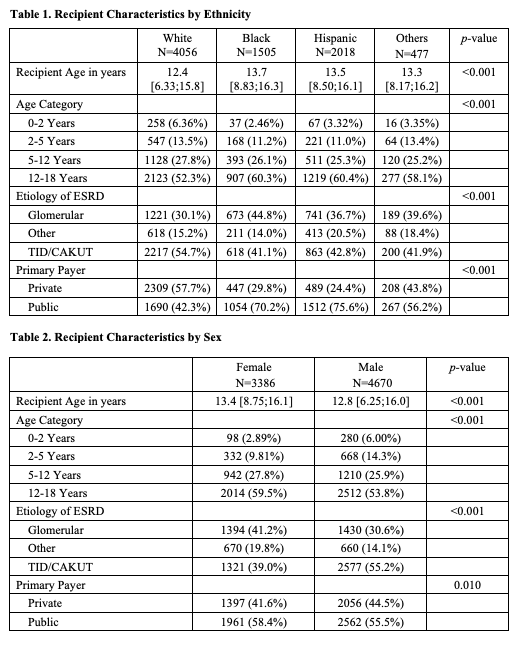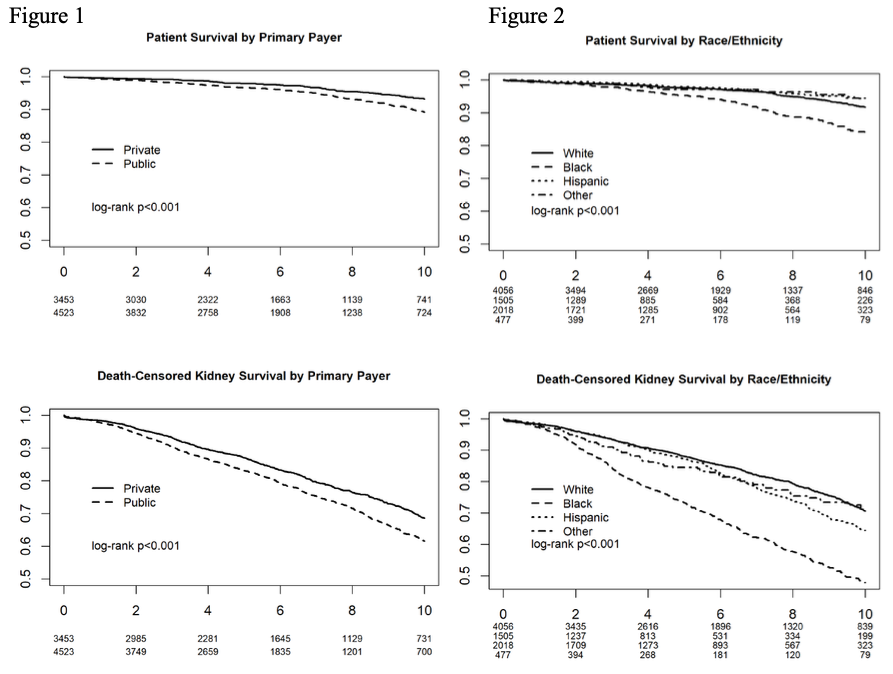Outcome Disparities of Primary Pediatric Kidney Transplant Recipients by Payor, Ethnicity and Gender in the United States
1Medicine, University of Minnesota, Minneapolis, MN, 2Complex Care Analytics, Fairview Health Services, Minneapolis, MN, 3Surgery, University of Minnesota, Minneapolis, MN, 4Pediatric, University of Minnesota, Minneapolis, MN
Meeting: 2020 American Transplant Congress
Abstract number: B-053
Keywords: African-American, Hispanic, Pediatric, Survival
Session Information
Session Name: Poster Session B: Kidney: Pediatrics
Session Type: Poster Session
Date: Saturday, May 30, 2020
Session Time: 3:15pm-4:00pm
 Presentation Time: 3:30pm-4:00pm
Presentation Time: 3:30pm-4:00pm
Location: Virtual
*Purpose: Racial disparity outcome in pediatric kidney recipients has been reported. We sought to assess other predictors of outcomes disparities.
*Methods: Using the SRTR database, between 1995 and 2017, there were 8056 primary pediatric kidney recipients suitable for analysis. Kaplan Meier curves were generated for patients and graft survival by payer type and ethnicity. Predictors for patients and grafts survival were examined using Cox proportional hazards models. Due to non-proportional hazards, the patient survival model was stratified by recipient age, and the graft survival model by ethnicity and cause of ESRD. Models were adjusted for age, sex, induction type, HLA mismatches, PRA, transplant year, ESRD cause, donor gender, age and type, steroid maintenance and payor type with transplant center included as a random effect. All recipients were on tacrolimus and mycophenolate with or without steroids.
*Results: There were 4056 Whites, 1505 Blacks, 2018 Hispanics, and 477 others (Table 1). 58 % were males (Table 2) and 56 % received public insurance. Recipients of public payor had worse patient and graft survival as compared to those with private payor (Figure 1). Black recipients had worse patient and graft survival (Figure 2). Public payor status was associated with 61.5% increased risk of death [HR 1.615, 95% CI (1.27,2.06) P < 0.001] and 21.6% increased risk of graft loss [HR 1.216, 95% C.I. (1.09, 1.35) P <0.001]. As compared to White, Black recipients had 51.2 % increased risk of mortality [HR 1.512, 95% CI (1.13, 2.03) P 0.002] while Hispanic recipients had 43.9% less risk of mortality [HR 0.561, 95% CI (0.40, 0.76) P <0.001]. Male recipients had 34.1% lower risk of death [HR 0.659, 95% CI (0.528, 0.822) P < 0.001] and 25.7% better graft survival [HR 0.743, 95% CI (0.674, 0.82) P < 0.001].
*Conclusions: Payor, Ethnicity and gender are independent predictors of outcome disparities among pediatric primary kidney recipients. Efforts should be devoted to understanding the implicating factors to help resolve these disparities.
To cite this abstract in AMA style:
Riad SM, Jackson S, Matas A, Chinnakotla S, Verghese P. Outcome Disparities of Primary Pediatric Kidney Transplant Recipients by Payor, Ethnicity and Gender in the United States [abstract]. Am J Transplant. 2020; 20 (suppl 3). https://atcmeetingabstracts.com/abstract/outcome-disparities-of-primary-pediatric-kidney-transplant-recipients-by-payor-ethnicity-and-gender-in-the-united-states/. Accessed December 17, 2025.« Back to 2020 American Transplant Congress


